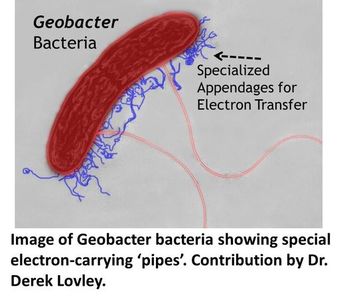Unlike any other living thing on Earth, electric bacteria use energy in its purest form - naked electricity in the shape of electrons harvested from rocks and metals. We already knew about two types, Shewanella and Geobacter. Now, biologists are showing that they can entice many more out of rocks and marine mud by tempting them with a bit of electrical juice. Experiments growing bacteria on battery electrodes demonstrate that these novel, mind-boggling forms of life are essentially eating and excreting electricity.
That should not come as a complete surprise, says Kenneth Nealson at the University of Southern California, Los Angeles. We know that life, when you boil it right down, is a flow of electrons: "You eat sugars that have excess electrons, and you breathe in oxygen that willingly takes them." Our cells break down the sugars, and the electrons flow through them in a complex set of chemical reactions until they are passed on to electron-hungry oxygen.
In the process, cells make ATP, a molecule that acts as an energy storage unit for almost all living things. Moving electrons around is a key part of making ATP. "Life's very clever," says Nealson. "It figures out how to suck electrons out of everything we eat and keep them under control." In most living things, the body packages the electrons up into molecules that can safely carry them through the cells until they are dumped on to oxygen. "That's the way we make all our energy and it's the same for every organism on this planet," says Nealson. "Electrons must flow in order for energy to be gained. This is why when someone suffocates another person they are dead within minutes. You have stopped the supply of oxygen, so the electrons can no longer flow. The discovery of electric bacteria shows that some very basic forms of life can do away with sugary middlemen and handle the energy in its purest form - electrons, harvested from the surface of minerals. "It is truly foreign, you know," says Nealson. "In a sense, alien."
| Nealson's team is one of a handful that is now growing these bacteria directly on electrodes, keeping them alive with electricity and nothing else - neither sugars nor any other kind of nutrient. The highly dangerous equivalent in humans, he says, would be for us to power up by shoving our fingers in a DC electrical socket. To grow these bacteria, the team collects sediment from the seabed, brings it back to the lab, and inserts electrodes into it. First they measure the natural voltage across the sediment, before applying a slightly different one. A slightly higher voltage offers an excess of electrons; a slightly lower voltage means the electrode will readily accept electrons from anything willing to pass them off. Bugs in the sediments can either "eat" electrons from the higher voltage, or "breathe" electrons on to the lower-voltage electrode, generating a current. That current is picked up by the researchers as a signal of the type of life they have captured. "Basically, the idea is to take sediment, stick electrodes inside and then ask 'OK, who likes this?'," says Nealson. | Full story: http://www.newscientist.com/article/d... |

 RSS Feed
RSS Feed